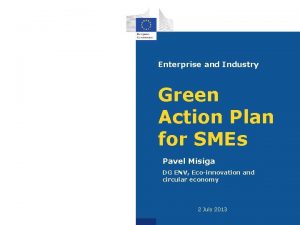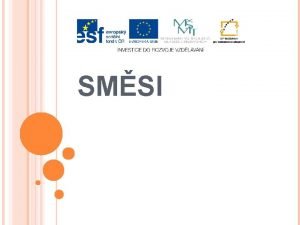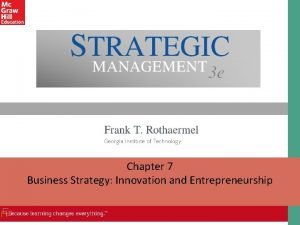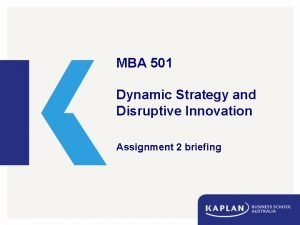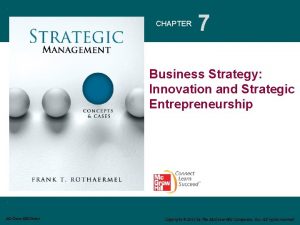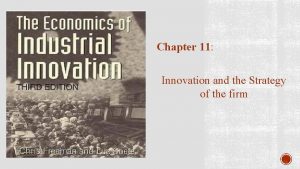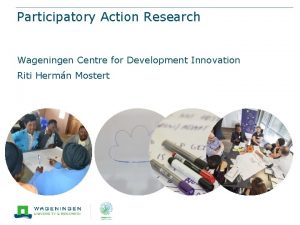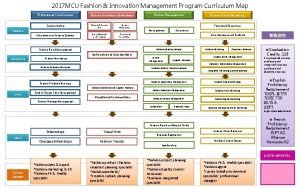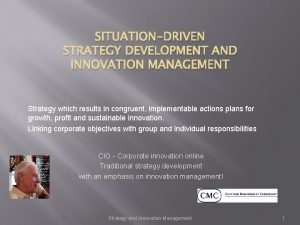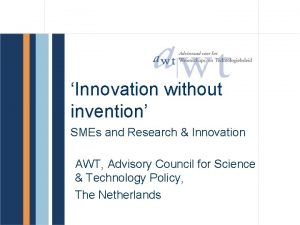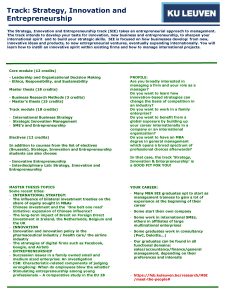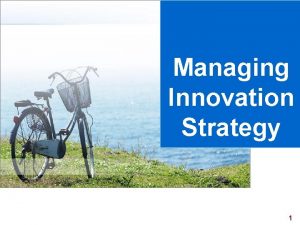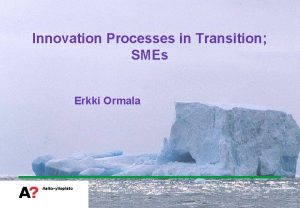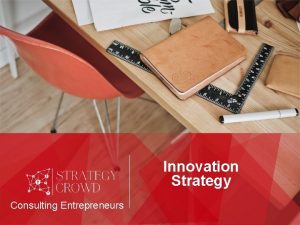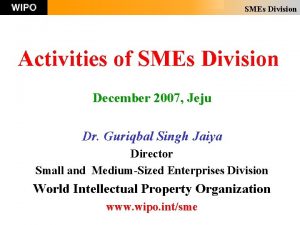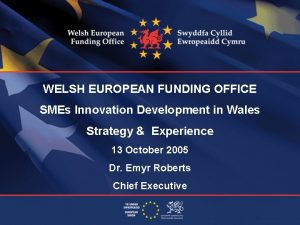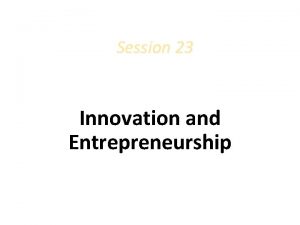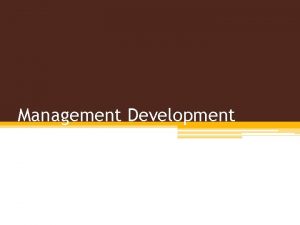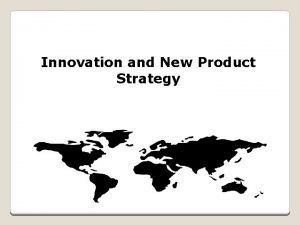Situationdriven strategy development and innovation management for SMEs



























- Slides: 27

Situation-driven strategy development and innovation management for SMEs and other organizations A strategy which results in congruent, implementable actions plans for growth, profit, service excellence and sustainable innovation. Linking corporate objectives with group and individual responsibilities Traditional strategy development but with an emphasis on innovation management and making strategy happen! 2/20/2021 Strategy development and Innovation management by CIO 1

Situation-driven strategy development and innovation management Table of Contents Three steps to developing a practical, implementable strategy while addressing innovation management. Step One; understand the organization’s strategic/innovation situation Step two; select a strategy Step three; make it happen http: //www. corporateinnovationonline. com Researching and articulating innovation management best practices 2/20/2021 Strategy development and Innovation management by CIO 2

Introduction Key Components of a Situation-driven strategy - A full understanding of competitors’ strategy and approach to innovation - Industry developments and societal trends - The corporation’s spectrum and depth of innovation compared to the competition or other benchmark - Cultural assessment as a precursor to implementation - Congruency checks to rigorously integrate proposed actions with strategic direction - Risk assessment related to change 2/20/2021 Strategy development and Innovation management by CIO 3

How does innovation management change strategy? • By knowing the innovation spectrum; i. e. breadth and depth, of the competition, the organization is in a better position to understand the priorities for strategic development and achieving sustainable innovation and growth • By articulating the approach to innovation management, priorities are identified and investment decision making is improved • Risk assessment for key decision making is more easily quantifiable 2/20/2021 Strategy development and Innovation management by CIO 4

Characteristics of the methodology • • Background research on industry and competition SME/organization provided data External interviews as required Internal interviews Use of on-line survey as required Workshops for each of the three steps Board and broad consultation as required Implementation involvement as required Proven methodology and understood by all participants Fully interactive with senior management 2/20/2021 Strategy development and Innovation management by CIO 5

Three steps Step One; Establishing SME’s/organizations Strategic Situation and Innovative Capacity Step Two; Selecting a Strategy Step three; Making strategy happen by using KRAs 2/20/2021 Strategy development and Innovation management by CIO 6

Summary of the full process Step One; understand the company’s strategic/innovation situation • • • Gather intelligence and analyze. Define the industry and the business segment Understand competitive intensity SWIOT analysis The spectrum of innovation at Starbucks Understand the key success factors (Bof. C) relative to the competition • Characterize the strategic/innovation situation Step Two; select a strategy • • • Selecting a Strategy Evaluating alternate strategies for the business unit, leading to the preparation of action plans Think about ‘natural’ strategic option zones based on the strategic situation Selecting a Strategy Risk analysis is based on many elements Step Three; make it happen • Making strategy happen by making use of KRAs • The implementation of action plans requires a consideration of many factors • Understand group key results areas and individual responsibilities • A format for individual establishing ‘Key Result Areas’ 2/20/2021 Strategy development and Innovation management by CIO 7

Step One Establishing SME’s Strategic Situation and Innovative Capacity 2/20/2021 Strategy development and Innovation management by CIO 8

Establishing SME’s Strategic Situation and Innovative Capacity; Step one. Gather intelligence and analyze Define the industry and the business segment • • • • Size of industry Growth over time, price trends Key influences on industry growth Competition Organizational nature of the competition Innovation spectrum of the competition Product line concept Basis of competition Barriers to entry Facilities factors Financial operating characteristics Role of technology Constraints 2/20/2021 Strategy development and Innovation management by CIO 9

Establishing SME’s Strategic Situation and Innovative Capacity; Step one. Understand competitive intensity Courtesy of Michael E. Porter, Competitive Strategy Risk is much higher in intensely competitive environments Potential Entrants Threat of New Entrants Industry Competitors Suppliers Buyers Rivalry Among Existing Firms Bargaining Power of Suppliers Bargaining Power of Buyers Threat of Substitute Products or Services Substitutes 2/20/2021 Strategy development and Innovation management by CIO 10

Establishing SME’s Strategic Situation and Innovative Capacity; Step one. SWIOT analysis Picture attributed to Booz and Company • Strengths – traditional approach • Weaknesses – traditional approach • Innovation spectrum; breadth and depth – new! • Opportunities – traditional approach • Threats – traditional approach 2/20/2021 Strategy development and Innovation management by CIO 11

Establishing SME’s Strategic Situation and Innovative Capacity; Step one. An example The spectrum of innovation at Starbucks had made the point that it wishes to be the ‘coffee authority’, meaning that it needs to have, at all times, a definitive and deep knowledge – know how - of the complete supply chain for coffee. The company needs to be the best in the business. Roasting and processing coffee is at the heart of the technology of Starbucks business. There is both a science component and much art associated with the process of making an exceptional brew. The combination of the science and the art is the ‘know how’ of the business and this is what Starbucks has brought to the market along with effective sourcing and a flair for retail marketing. Basic to the success of Starbucks is that it is, in the minds of millions of customers, a good tasting brew; and better than most! 2/20/2021 Strategy development and Innovation management by CIO 12

Establishing SME’s Strategic Situation and Innovative Capacity; Step one. The spectrum of innovation Industry/market/customer-centric 'Innovation interest' with minimal risk Business process continuous improvement Product line extensions New products New business models 2/20/2021 Technology 'Innovation interest' with nominal risk 'Innovation interest' in common-use technologies to keep up to date. 'Innovation interest' in a defined market in order to differentiate product/service. 'Innovation interest' in emerging technologies. R&D 'Innovation interest' with higher risk Applied Science / Fundamental science "Innovation interest ' in research Strategy development and Innovation management by CIO 13

Starbucks Innovation Profile An example of the spectrum of innovation Type of Innovation Evidence of Innovation by Type of Innovation Comment Science Fundamental Science None Not expected in this industry Applied Science VIA development based on the chemistry of ‘freeze-dried’ technology/ Roast curve relationship Unusual depth for this industry Technology Research R&D spending as a % of sales/ Intent to be the ‘coffee authority’: maintaining a watchful eye on developments/‘Know how’ Emerging technologies ? Coffee is in Starbucks DNA Unclear Differentiating technologies Quality of product/ R&D to develop less expensive soluble powders [e. g. VIA]/ Sandwiches without a cheese smell/ Ethically-sourced coffee/ Merging coffee with a ‘place’ Common-use technologies Loyalty program/ Clover equipment/ Mastrena equipment to improve quality, speed, and view Combination of ‘technologies’ provides the differentiation Keeping up to date with technology New business models Store design/ Integrating coffee roasting with sales and with both bean and drink Fundamental shifts in the industry New products Store design [seating, Wi-fi, comfort/‘Street-named’ stores/ Coffee quality and price/ Pike Place Roast/ Frappucino/ Coffee – ‘bold’/ Sandwiches/ Branding realization [e. g. Digital Ventures]/ VIA/ Renaming coffee to designate taste rather than bean Probably the strongest Starbucks type of innovation Product extensions Store openings/ Coffee variations/ Sandwich selections/ Coffee but in out-of-store locations/ Limited This type of innovation has release reserve coffees propelled growth Business/continuous improvement IT/ In-store information systems/ Mastrena = speed Came as an afterthought after Starbucks decline Innovation refers to the experimentation and adoption of new ideas of all kinds. Inherent in an idea is always the notion of change; grand or small, and the assumption of risk. Without risk, there is no innovation! The term ‘innovation interest’ is used to note that not all innovations are physical but can be emotional and may at times be simply thoughts which do not translate, for many reasons, into actions or new products/services. 2/20/2021 Strategy development and Innovation management by CIO 14

Note; Establishing SME’s Strategic Situation and Innovative Capacity; Step one. Measures to move forward Some external measure – a comparison - is necessary to make realistic the chosen strategy. For every type of organization, there is a source for making comparisons. Whether a ‘for profit’ or ‘not for profit’ organization, it is useful to have another organization or set of performance factors to compare with your own organization. • For industry; choose a competing organization with a well-known reputation for innovation. Use survey of customer/employee opinions. • For ‘not for profits’; choose a similar organization which is renowned for its effectiveness. Use a survey of users of the service. • For government; check out the various sources of good governance. 2/20/2021 Strategy development and Innovation management by CIO 15

Establishing SME’s Strategic Situation and Innovative Capacity; Step one. Understand the key success factors (Basis of competition) relative to the competition. Example is from a manufacturing company. Basis of Competition Notes: In some cases it may be useful to provide relative weights to each of the bases. If there is likely to be a shift to a different bases in the future, a second set of bases should be developed. 2/20/2021 Company A Company B Company C Low cost manufacturing + 0 - Response time to customer order -- + ++ Product Quality 0 ++ - ++ + - Product functionality - - - Sales force training Overall result - + -- Innovative capacity -1 Strategy development and Innovation management by CIO +4 Your company? -3 16

Selecting a Strategy; Step Two Get it out! 2/20/2021 Strategy development and Innovation management by CIO 18

Select a strategy; Step Two Evaluating alternate strategies for the business unit, leading to the preparation of action plans Competitive Intensity Strategic/innovative Situation Thrust Selection Potential Competitor Reactions Risk Analysis Competitive Position Reference ‘natural’ strategy selection Strategy Options Strategy Selection Capacity for Improvements Financial Implications Translation of the Strategy into Tactical and Action Plans 2/20/2021 Strategy development and Innovation management by CIO 19

Select a strategy; Step Two Think about ‘natural’ strategic option zones based on the SME’s strategic Stages of Industry situation Competitive Position Dominant Strong Favorable Embryonic Growth “Unnatural” strategic thrusts are more risky and often are based on ambition and not on a realization of the company’s ‘strategic/innovative situation’. Mature Maturity Natural Development Selective Development Prove Viability Tenable Exit Strategy Weak 2/20/2021 Aging Strategy development and Innovation management by CIO 20

Select a strategy; Step Two Selecting a Strategy 1. Determine the company’s current situation 2. Examine a range of thrusts and strategic options and short list a small number 3. Evaluate the short list of strategic options and select one or two for further development 4. Describe more fully the selected option and its implications. Check the options congruence with overall corporate goals 5. Develop action plans which will make it happen! 2/20/2021 Strategy development and Innovation management by CIO 21

Select a strategy; Step Two Risk analysis is based on many elements Elements of Risk Low Medium High Level of Risk Industry Risk is inherent in the development of any strategy and for every assumption. Decisions taken to act or not act carry a strategic implication and risk. Risk derives from industry maturity and competitive position but other elements also come into play. 2/20/2021 Maturity Competitive Position Strategy Assumptions Innovation management practices Past performance of the unit Past performance of management Level of future performance required Strategy development and Innovation management by CIO Overall Risk 22

Translating Strategy into Action by Groups and Individuals; Step Three 2/20/2021 Strategy development and Innovation management by CIO 23

Translating Strategy into Action by Groups and Individuals; Step Three Making strategy happen by making use of KRAs SME Goals Alignment of individual actions with the chosen strategy is the key to performance improvement Individual ‘Benchmark Objectives’ 2/20/2021 The ‘Management Team’ is involved in all aspects of the work and at all levels in the organization. SME Strategy Implementation requires compatibility between strategy and organization. Two or three iterations may be required to properly align all the resources within any one organization. Strategy development and Innovation management by CIO 24

Translating Strategy into Action by Groups and Individuals; Step Three The implementation of action plans requires a consideration of many factors including, most importantly, the culture of the organization Tactical Strategies Multi-Year Development of Action Plans Organization Arrangements Organization Structure Decentralization of Responsibilities * For more information on a ‘culture for innovation’, visit the web site. 2/20/2021 Culture for Innovation* Management Systems Critical Driving Forces Information and Control Systems Management Style Performance Measurement and Reward Systems Functional Strategies Operations Marketing Human Resources Infrastructure and Support Systems Technology Financial Manager - Subordinate Development of Key Result Areas Strategy development and Innovation management by CIO 25

Translating Strategy into Action by Groups and Individuals; Step Three Understand group key results areas (KRAs) and individual responsibilities The following questions aim at identifying, for each position, significant key result ‘areas’ • In what areas would improved performance significantly and favorably affect company performance? What actions are necessary and by when? • In what areas could poor performance do damage to the company? What actions are necessary and by when? • Examples of ‘statements’ - to achieve the budgeted level of sales; $$$ - to control scrap level; %%% - to ensure that resource capacity is fully utilized; %%% 2/20/2021 Strategy development and Innovation management by CIO 26

Translating Strategy into Action by Groups and Individuals; Step Three A format for individual establishing ‘Key Result Area’ responsibilities Six topics to address in the development of a KRA. No matter what ‘format’ is used, the key is to provide a clear understanding amongst the group and between each manager and subordinate. • • A. Main Purpose of Job and Congruence with Strategy B. Position in the Organization C. Scope of the Job D. Key Tasks Output, Costs, Use of Resources, Quality • E. Personnel Activities • F. Limits of Authority 2/20/2021 Strategy development and Innovation management by CIO Not a rope to hand yourself!! 27

The End CIO hopes that you found this approach to strategy development of interest and can make use of the methodology. Innovation should be an integral component of the development of any strategy Further information is available on the web site; http: //www. corporateinnovationonline. com 2/20/2021 Strategy development and Innovation management by CIO 28
 Různorodá směs navzájem rozptýlených kapalin
Různorodá směs navzájem rozptýlených kapalin Polymerbeton směs
Polymerbeton směs Green action plan for smes
Green action plan for smes Různorodá směs nerostů
Různorodá směs nerostů Heterogenní směs
Heterogenní směs Frf for smes vs gaap
Frf for smes vs gaap Innovation for the sake of innovation
Innovation for the sake of innovation Incremental innovation vs disruptive innovation
Incremental innovation vs disruptive innovation Types of innovation in entrepreneurship
Types of innovation in entrepreneurship Dynamic strategy and disruptive innovation
Dynamic strategy and disruptive innovation Strategy innovation and entrepreneurship
Strategy innovation and entrepreneurship Hypercompetition
Hypercompetition Defensive innovation strategy
Defensive innovation strategy Rdi research development innovation
Rdi research development innovation Action wageningen
Action wageningen Fashion and innovation management
Fashion and innovation management Business strategy vs corporate strategy
Business strategy vs corporate strategy Production plan example
Production plan example Fspos
Fspos Typiska drag för en novell
Typiska drag för en novell Tack för att ni lyssnade bild
Tack för att ni lyssnade bild Returpilarna
Returpilarna Varför kallas perioden 1918-1939 för mellankrigstiden
Varför kallas perioden 1918-1939 för mellankrigstiden En lathund för arbete med kontinuitetshantering
En lathund för arbete med kontinuitetshantering Särskild löneskatt för pensionskostnader
Särskild löneskatt för pensionskostnader Tidbok för yrkesförare
Tidbok för yrkesförare Sura för anatom
Sura för anatom Densitet vatten
Densitet vatten


